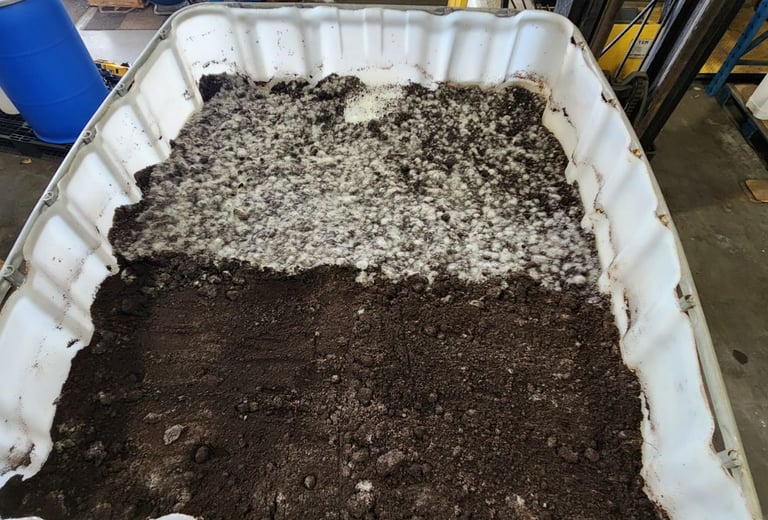The Crucial Roles of Soil Fungi in Agriculture
SOIL BIOLOGYSOIL PHYSICSCOVER CROPPINGSOIL FERTILITYREGEN AG


This article explores the crucial roles of soil fungi in agriculture, detailing how common taxa like Arbuscular Mycorrhizal Fungi (AMF) and Saprophytic Fungi enhance nutrient uptake, improve soil structure, and protect plants from pathogens. It also examines the effectiveness of fungal inoculants as farm inputs and highlights the impact of soil structure on fungal activity. The article underscores the importance of sustainable soil management practices to optimize the benefits of fungi in agricultural systems.
The Essential Roles of Soil Fungi in Agriculture
Soil fungi are crucial players in agricultural ecosystems, where they perform essential functions that benefit plant health and soil fertility. These microorganisms engage in complex interactions with plants and the soil environment, secreting substances that enhance nutrient availability, improve soil structure, amplify access to soil water, and protect plants from pathogens. This article explores the roles of common soil fungal taxa, how they function, and the specific benefits they provide to plants.
Common Soil Fungal Taxa and Their Functions
1. Arbuscular Mycorrhizal Fungi (AMF) – Glomeromycota:
Arbuscular mycorrhizal fungi form symbiotic relationships with the roots of most terrestrial plants. Through their extensive hyphal networks, AMF increase the surface area for water and nutrient absorption, particularly phosphorus. They secrete enzymes such as phosphatases and organic acids that solubilize phosphorus from soil minerals, making it more available to plants. AMF also secrete glomalin, a glycoprotein that contributes to soil aggregation and structure, enhancing water retention and reducing erosion.
2. Saprophytic Fungi – Ascomycota and Basidiomycota:
Saprophytic fungi, including those from the Ascomycota and Basidiomycota phyla, are key decomposers in the soil. They break down complex organic matter, such as lignin and cellulose, through the secretion of extracellular enzymes like cellulases and ligninases. This decomposition process releases essential nutrients, such as nitrogen, phosphorus, and carbon, back into the soil, making them available for plant uptake. The organic matter broken down by these fungi also contributes to the formation of humus, which improves soil structure and fertility.
3. Endophytic Fungi:
Endophytic fungi live within plant tissues, often without causing any harm. These fungi can produce secondary metabolites, such as alkaloids and terpenoids, which help protect plants from herbivores and pathogens. Additionally, endophytic fungi can enhance plant growth by producing growth-promoting hormones like auxins, which stimulate root development and improve nutrient uptake.
4. Ectomycorrhizal Fungi (EMF):
Ectomycorrhizal fungi form mutualistic relationships with the roots of many tree species. Unlike AMF, EMF do not penetrate the root cells but instead form a sheath around the root, known as a Hartig net. These fungi enhance the absorption of nutrients, particularly nitrogen, by secreting proteolytic enzymes that break down organic nitrogen compounds into forms that plants can assimilate. EMF also contribute to soil stability by binding soil particles together, reducing erosion and enhancing soil structure.
For more detailed information on soil fungal taxa and their functions, you can explore resources from the NSW Department of Primary Industries.
How Certain Farming Practices Inhibit Soil Fungi
1. Excessive Tillage:
Tillage disrupts the soil structure, breaking up the delicate hyphal networks that fungi use to access nutrients and water. This damage reduces the ability of fungi, particularly mycorrhizal fungi, to form beneficial relationships with plant roots, thus limiting nutrient uptake and soil stability.
2. Overuse of Chemical Fertilizers:
High levels of synthetic fertilizers, especially those rich in nitrogen and phosphorus, can alter soil pH and disrupt the balance of nutrients available in the soil. These changes can inhibit the growth and activity of beneficial soil fungi, which often thrive in more balanced, nutrient-diverse environments. Furthermore, chemical fertilizers can lead to an overabundance of certain nutrients, reducing the need for plants to engage in symbiotic relationships with fungi, particularly mycorrhizal fungi.
3. Heavy Pesticide Applications:
Pesticides, particularly fungicides, can have a direct detrimental effect on beneficial soil fungi. While intended to target harmful pathogens, these chemicals can also kill or inhibit beneficial fungi that are crucial for nutrient cycling, disease suppression, and organic matter decomposition. This disruption can lead to reduced soil fertility and a decline in overall soil health.
To explore these topics further and understand how to promote healthier soil ecosystems, you can visit resources like NSW DPI and Farmers.gov.
Evaluating the Use of Fungi as Farm Inputs
The use of soil fungi, particularly mycorrhizal fungi, as farm inputs has been studied extensively. These studies assess their effectiveness in promoting plant growth, enhancing nutrient availability, and improving crop resilience.
1. Proven Benefits:
Research has demonstrated the effectiveness of mycorrhizal inoculants in enhancing phosphorus uptake and improving plant growth, particularly in nutrient-poor soils. The symbiotic relationship between AMF and plants can lead to increased yields, especially in low-input systems where synthetic fertilizers are limited.
2. Challenges and Limitations:
Despite these benefits, the success of fungal inoculants is influenced by various factors, including soil pH, moisture levels, and existing microbial communities. In some cases, the introduced fungi may not establish effectively or may be outcompeted by native soil microbes, limiting their utility.
3. Potential Improvements:
Ongoing research is focused on developing fungal consortia that combine multiple fungal species with complementary functions, enhancing their overall effectiveness. Additionally, improving soil management practices, such as maintaining organic matter and reducing soil disturbance, can create more favorable conditions for fungal activity.
For more insights into the research on beneficial soil fungi and their applications, visit Agriculture and Agri-Food Canada and Farmers.gov.
The Role of Compost Extracts in Enhancing Fungal Activity
Compost extracts are increasingly used to introduce beneficial fungi into agricultural soils. These extracts, rich in organic matter and microorganisms, can enhance fungal diversity and contribute to soil health.
Pros:
Enhanced Fungal Activity: Compost extracts introduce beneficial fungi that can improve nutrient cycling and plant health.
Soil Structure Improvement: The organic matter in compost extracts helps improve soil structure, enhancing water retention and creating a favorable environment for fungal activity.
Cons:
Variable Effectiveness: The success of compost extracts can be inconsistent, depending on factors such as soil type and existing microbial communities.
Cost and Labor: Preparing and applying compost extracts can be labor-intensive and costly, particularly on a large scale.
For more information on compost extracts and their role in agriculture, visit the Rodale Institute.
The Impact of Soil Structure on Fungal Activity
Soil structure plays a critical role in the success of native fungi, fungal inoculants and other biological inputs in agriculture. In particular, compacted or slaking-prone soils can inhibit fungal activity by restricting water, and gas exchange (aeration)
1. Impaired Water and Gas Exchange:
In compacted soils, water infiltration and gas exchange are restricted, creating anaerobic conditions that are unfavorable for most soil fungi. This limitation can reduce the effectiveness of fungal inoculants and native species, as fungi require adequate oxygen and moisture to thrive. Maintaining a disciplined traffic plan and using tram lines are beneficial practices to prevent the collapse of soil pore space fungi require to thrive.
2. Improving Soil Structure:
To maximize the benefits of fungal inoculants, improving soil structure is essential. Practices such as cover cropping, reduced tillage, and the addition of soluble calcium & organic amendments can enhance soil aggregation, improve porosity, and support better fungal activity. Again, a disciplined traffic plan and using tram lines are beneficial practices to prevent the collapse of soil pore space fungi require to thrive.
For more information on the impact of soil structure on fungal activity, explore resources from the NSW Department of Primary Industries.
Soil fungi play essential roles in agricultural ecosystems, contributing to nutrient cycling, organic matter decomposition, water use, and plant health. While fungal inoculants offer potential benefits, their effectiveness is influenced by soil structure and environmental conditions. By improving soil management practices and selecting the right fungal strains, farmers can harness the power of soil fungi to enhance soil health and boost crop yields.
For more insights into the role of soil fungi in agriculture and effective management practices, explore resources from Farmers.gov, the NSW Department of Primary Industries, and Agriculture and Agri-Food Canada.




